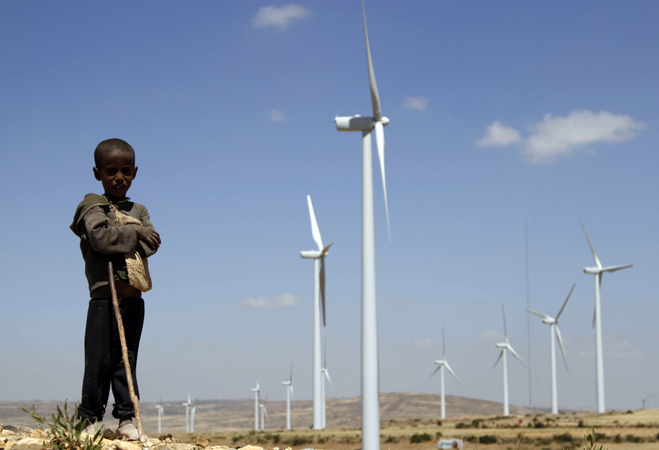The $290m Ashegoda Wind Farm is expected to generate 120MW of electricity, easing Ethiopia's dependence on hydropower.Last Modified: 27 Oct 2013 15:02 |
 Ashegoda Wind Farm is expected to ease Ethiopia's dependence on hydropower [Reuters] |
| Africa's biggest wind farm has begun production in Ethiopia, aiding efforts to diversify electricity generation from hydropower plants and help the country become a major regional exporter of energy Africa's second most populous country - plagued by frequent blackouts - plans to boost generating capacity from 2,000 MW to 10,000 MW within the next three to five years. Much of the increase would come from the 6,000 MW Grand Renaissance Dam under construction on the Nile. The US $290m Ashegoda Wind Farm was built by French firm Vergnet SA with concessional loans from BNP Paribas and the French Development Agency (AFD). The Ethiopian government covered 9 percent of the cost. "Various studies have proved that there is potential to harness abundant wind energy resources in every region of Ethiopia. We cannot maintain growth without utilising the energy sector," Prime Minister Hailemariam Desalegn said in a speech at the launch. Experts put Ethiopia's hydropower potential at around 45,000 MW and geothermal at 5,000 MW, while its wind power potential is believed to be Africa's third-largest behind Egypt and Morocco. Delayed completion Groundbreaking for the Ashegoda Wind Farm was done in 2009 with completion set for 2011 but logistical constraints delayed its finish. It is the second such project in the country after the 51 MW Adama I wind farm, which began production in 2011. "Ethiopia might have one of the most impressive investment plans in renewable energy in Africa," Vergnet's site manager Roman Coutrot, said. "It's not only talking, they are acting and signing contracts. The problem they might face is financing but they are not worried about that," he said. The 84-turbine farm - straddling a sprawling field of grassland dotted by stone-brick hamlets more than 780km north of the capital Addis Ababa - is part of a plan to mitigate the impact of dry seasons on the country's dams. At present, Ethiopia's energy resources are almost completely derived from hydropower projects. "It compliments hydropower, which is seasonal. When you have a dry water season we have higher wind speed," said Mihret Debebe, CEO of the Ethiopian Electric Power Corporation. "There is harmony between the two sources of energy." Last week, Ethiopia also signed a preliminary agreement with a US-Icelandic firm for a $4 billion private sector investment intended to tap its vast geothermal power resources and produce 1,000 MW from steam. |

Mega Damming of the Life giving waters of Ethiopia. This process is menacing the existence of the inhabitants of the region by drying the sources and lakes. The main reason advertised for damming is for production of Electricity and exporting energy. This could be done by small human level dams.The underlying reason is to the irrigation for the great land grabbing for cash crop exportation for financial speculators. Moreover, such mega projects leads to undue water crisis.
Monday, October 28, 2013
Africa's biggest wind farm opens in Ethiopia - Africa - Al Jazeera English
Subscribe to:
Post Comments (Atom)




No comments:
Post a Comment